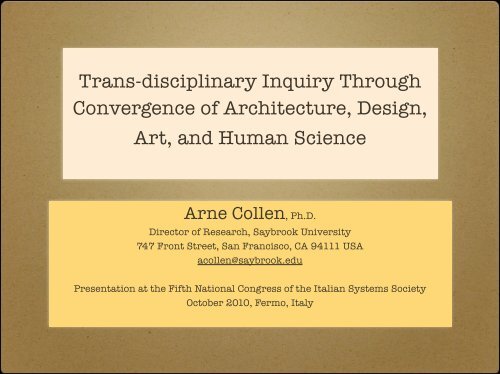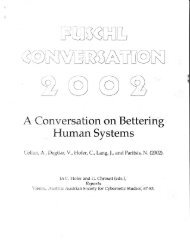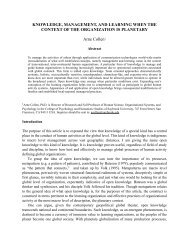Trans-disciplinary Inquiry Through Convergence of ... - Arne Collen
Trans-disciplinary Inquiry Through Convergence of ... - Arne Collen
Trans-disciplinary Inquiry Through Convergence of ... - Arne Collen
You also want an ePaper? Increase the reach of your titles
YUMPU automatically turns print PDFs into web optimized ePapers that Google loves.
<strong>Trans</strong>-<strong>disciplinary</strong> <strong>Inquiry</strong> <strong>Through</strong><br />
<strong>Convergence</strong> <strong>of</strong> Architecture, Design,<br />
Art, and Human Science<br />
<strong>Arne</strong> <strong>Collen</strong>, Ph.D.<br />
Director <strong>of</strong> Research, Saybrook University<br />
747 Front Street, San Francisco, CA 94111 USA<br />
acollen@saybrook.edu<br />
Presentation at the Fifth National Congress <strong>of</strong> the Italian Systems Society<br />
October 2010, Fermo, Italy
Introduction<br />
The questions posed for inquiry and demands on<br />
knowing to address contemporary problems through<br />
research make it increasingly difficult with each<br />
passing decade for us to expect answers that can<br />
come from a single discipline.
Introduction<br />
Water pollution involves more than simply<br />
consulting a chemist.<br />
Species extinction is not the sole interest <strong>of</strong><br />
biologists.<br />
Genetic mutation attracts researchers in fields<br />
adjacent to genetics.<br />
Poverty has gone beyond the purview <strong>of</strong> the<br />
economist and sociologist.
Introduction<br />
There are multiple factors relevant to a phenomenon<br />
<strong>of</strong> interest. In each case, a set <strong>of</strong> disciplines and<br />
fields <strong>of</strong> study emerges that is best positioned to<br />
inform us about each relevant factor.<br />
Hence, reason and motivation for inter-, multi-,<br />
cross-, and trans-<strong>disciplinary</strong> research.
Introduction<br />
The purpose <strong>of</strong> this presentation is to discuss that<br />
architecture, design, art, and human science<br />
represent an important convergence illustrative <strong>of</strong><br />
trans-disciplinarity.<br />
They perpetuate a long-standing association<br />
expressed in our built environments.<br />
The convergence <strong>of</strong>fers a plentitude <strong>of</strong> foci for<br />
trans-<strong>disciplinary</strong> research.
<strong>Trans</strong>-disciplinarity<br />
The nature <strong>of</strong> trans-disciplinarity and trans<strong>disciplinary</strong><br />
research is systemic in its orientation<br />
and use <strong>of</strong> multiple perspectives.<br />
The focus is on the relationships human beings have<br />
with each other, other beings, and the environment.
<strong>Trans</strong>-<strong>disciplinary</strong> <strong>Inquiry</strong><br />
In trans-<strong>disciplinary</strong> inquiry, a social dynamism<br />
energizes inquiry, where the collaborators bring to<br />
the process their <strong>disciplinary</strong> expertise to bear on<br />
the research focus.
<strong>Trans</strong>-<strong>disciplinary</strong> <strong>Inquiry</strong><br />
The process is team oriented and collaborative with<br />
the common goal <strong>of</strong> addressing the research<br />
question from a multitude <strong>of</strong> perspectives.<br />
For example, the architect, designer, artist, and<br />
human scientist bring to the inquiry four important<br />
perspectives that collectively can provide a more<br />
comprehensive and informed answer to the research<br />
question than any one alone.
<strong>Trans</strong>-<strong>disciplinary</strong> <strong>Inquiry</strong><br />
Two particularly prominent aspects or dimensions<br />
complexify trans-<strong>disciplinary</strong> inquiry.<br />
The first concerns the number <strong>of</strong> inquirers that<br />
constitute the team <strong>of</strong> researchers.<br />
The second is the number <strong>of</strong> disciplines and fields<br />
<strong>of</strong> study pertinent to the inquiry.
Research Activity System<br />
Human Activity System (HAS) is a construct <strong>of</strong><br />
convenience and meaningful to conceptualize a<br />
group <strong>of</strong> persons interacting for an agreed upon<br />
purpose, common need, or shared pursuit.
Research Activity System<br />
The HAS devoted to trans-<strong>disciplinary</strong> inquiry may<br />
be termed a Research Activity System (RAS).
Research Activity System<br />
In my current pursuits, applications <strong>of</strong> RAS can be<br />
found under the acronym ADAHS, meaning<br />
Architecture, Design, Art, and Human Science.<br />
I have been developing this basis for trans<strong>disciplinary</strong><br />
studies at my university.<br />
Most recently, ADAHS was adopted as one focus<br />
for completing the Human Science graduate<br />
programs at my university.
ADAHS<br />
The focus is developing in close collaboration with<br />
our colleagues in the Department <strong>of</strong> Building and<br />
Environment Science and Technology (BEST) at<br />
the Politecnico di Milano, Italy.<br />
Salient in our collaboration is the experience <strong>of</strong><br />
space traversing the built environment organizing a<br />
place, conveyed via a range <strong>of</strong> research questions.<br />
We came to a common understanding that this<br />
general research focus was one worthy <strong>of</strong> trans<strong>disciplinary</strong><br />
studies within and between our<br />
education institutions.
ADAHS<br />
As a general research focus for trans-<strong>disciplinary</strong><br />
studies, ADAHS converges and integrates over the<br />
course <strong>of</strong> graduate study four main constructs:<br />
Architecture<br />
Art<br />
Design<br />
Human Science
Architecture<br />
Architecture is a discipline and pr<strong>of</strong>ession that<br />
concerns transecting and organizing the spaces<br />
human beings are to inhabit.<br />
Its practices result in spatial contexts designed to<br />
control, steer, and induce a wide range <strong>of</strong> behaviors<br />
and experiences.
Architecture<br />
The architect has been placed by definition <strong>of</strong> the<br />
discipline at the very center <strong>of</strong> designing our built<br />
environment.<br />
And for this centrality, it has seemed to us that this<br />
discipline is primary for trans-<strong>disciplinary</strong> studies<br />
<strong>of</strong> space and place.
Design<br />
Design has several meanings, all <strong>of</strong> which can be<br />
applied to trans-<strong>disciplinary</strong> research.<br />
Particular organizations <strong>of</strong> space can readily<br />
become templates <strong>of</strong> design. Prominent lines and<br />
curves, volumes and shapes, solids and empty<br />
hollows are important design features for<br />
transecting, sculpting, and organizing space.
Design<br />
Another kind <strong>of</strong> design is the configuration <strong>of</strong> all<br />
resources and persons that need to be coordinated to<br />
progress through all phases <strong>of</strong> any specific trans<strong>disciplinary</strong><br />
inquiry.<br />
In such uses, the construct is termed the research<br />
design <strong>of</strong> the inquiry.
Art<br />
Art enhances the human experience <strong>of</strong> space and<br />
place.<br />
Human beings have a compelling propensity to add<br />
and alter something in an artistic fashion to make<br />
the place a home.
Art<br />
Humans are the only living beings to our<br />
knowledge that engage in art making with<br />
intentionality and purpose generative <strong>of</strong> adding<br />
meaning to and evoking appreciation <strong>of</strong> their world.<br />
Art has become an inherent part <strong>of</strong> space and place<br />
as we experience them.
Art and Science<br />
The interplay <strong>of</strong> art and science is advantageous in<br />
trans-<strong>disciplinary</strong> studies.<br />
Where art reminds us <strong>of</strong> the innovative, creative,<br />
and intuitive sides <strong>of</strong> conducting inquiry, science<br />
reminds us <strong>of</strong> the training, decision rules, and<br />
proven step-by-step methodical procedures that<br />
ensure discipline in inquiry.<br />
But it does not to follow that one lacks in or should<br />
be kept separate from the other.
ADAHS<br />
ADAHS is inclusive <strong>of</strong> all disciplines and fields <strong>of</strong><br />
study pertinent to human beings and their environs.<br />
Since the middle <strong>of</strong> the twentieth century, human<br />
scientists converge from the social and behavioral<br />
sciences as well as the arts and humanities.<br />
From the disciplines <strong>of</strong> the human sciences, there<br />
are research methodologies being advanced for us<br />
to consider whether they are germane to a particular<br />
trans-<strong>disciplinary</strong> research study.
ADAHS<br />
• To seek knowledge with maximal generalizability is to<br />
foster trans-<strong>disciplinary</strong> knowledge.<br />
• <strong>Trans</strong>-<strong>disciplinary</strong> research is best communicated by<br />
the ideas <strong>of</strong> confluence and integration.
ADAHS<br />
• The thrust <strong>of</strong> ADAHS is programmatic research.<br />
• ADAHS provides an arena for students, faculty, and<br />
colleagues to conduct many studies that move toward<br />
the goals <strong>of</strong> the Human Science programs <strong>of</strong> the<br />
author’s university, as well as prompt parallel<br />
developments with my colleagues and collaborators in<br />
BEST, Milan, Italy.
ADAHS<br />
We posed a set <strong>of</strong> general questions that help to communicate parameters and<br />
potential directions for trans-<strong>disciplinary</strong> studies and research, as follows:<br />
• What contributions can the human sciences make to architectural design and decision-making for a better<br />
understanding <strong>of</strong> the ways people perceive their built environment<br />
• What advances can be made to improve methods <strong>of</strong> building processes, such as Post-Occupancy Evaluation<br />
and Building Performance Evaluation, and related methodologies and metrics, in assessing the “success” <strong>of</strong><br />
architectural projects and in improving the design decision- making process<br />
• With keener attention to the heritage values <strong>of</strong> historical urban settlements and landscape, what contributions<br />
can inhabitants’ perceptions <strong>of</strong> their built environment and their values make that can be brought to bear on<br />
architectural design and decision making<br />
• What can be done to improve the efficacious use <strong>of</strong> systemic approaches to architectural design and decision<br />
making<br />
• What social and psychological effects <strong>of</strong> architecture on our daily life are the critical ones to know and take<br />
into account in making built environments for healthier, “greener,” and ecologically more viable domiciles<br />
adjacent to as well as within larger communities<br />
• What qualities <strong>of</strong> and innovations for organising space foster transformative effects for human and ecological<br />
betterment without adverse secondary effects <strong>of</strong> environmental degradation<br />
• From the architects, builders and designers to the residents, what are the qualities and innovations that produce<br />
the landscape-dwelling interactions that produce and sustain their best practices for healthier living<br />
Table 1. General research questions for guiding ADAHS students and faculty in the Human Science graduate programs.
ADAHS<br />
Main Research Interests <strong>of</strong> Principals Became Aims <strong>of</strong> the Project<br />
• The systemic nature <strong>of</strong> architecture as a complex means to produce the built environment.<br />
• The concept <strong>of</strong> emergence to describe and analyze architecture and the built environment, as simpler higherlevel<br />
order processes resulting from the conscious and unconscious interactions <strong>of</strong> many agents in the more<br />
complex lower-level order processes, all belonging to the larger system represented by society as a whole.<br />
• The systemic contributions <strong>of</strong> different sciences to architectural design and decision making for a better<br />
understanding <strong>of</strong> the ways people perceive their built environment and social systems acquire emergent<br />
properties.<br />
• The importance <strong>of</strong> sound methods, such as Post-Occupancy Evaluation and Building Performance Evaluation,<br />
in assessing the built environment and in evaluating the success <strong>of</strong> architectural projects at different scales<br />
according to the users’ perceptions, thus <strong>of</strong>fering an important feedback methodology for the building activities<br />
as well as architectural practice.<br />
Table 2. Main subject interests and aims <strong>of</strong> the Project
ADAHS<br />
Research Foci <strong>of</strong> Special Importance<br />
• The systemic approach to architectural design and decision-making.<br />
• The contributions <strong>of</strong> the human sciences to architectural design and decision making for a better understanding<br />
<strong>of</strong> the ways people perceive their built environment.<br />
• The contributions <strong>of</strong> the science <strong>of</strong> complexity, its methods and models to the theoretical base <strong>of</strong> principles<br />
establishing the Project.<br />
• The social and psychological effects <strong>of</strong> architecture on our daily life.<br />
• The inhabitants’ perceptions <strong>of</strong> the built environment and their values, with keener attention to the heritage and<br />
landscape values <strong>of</strong> historical settlements.<br />
Table 3. Foci <strong>of</strong> special importance necessitating trans-<strong>disciplinary</strong> inquiry.
Conclusion<br />
Despite what might appear as grand statements <strong>of</strong><br />
promise and potential, our intentions are very<br />
modest in our convergence by means <strong>of</strong> ADAHS in<br />
the Human Science graduate programs and the<br />
collaborative Project between our two universities.<br />
It is our desire that these pursuits may contribute<br />
new graduates and advance knowledge domains for<br />
the larger cause <strong>of</strong> more humanistic and human<br />
science oriented built environments <strong>of</strong> the future.<br />
We invite your interest.
The End







